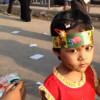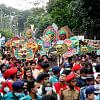So, it's official. The iconic Mangal Shobhajatra — that colourful, larger-than-life procession we all know and love on Pahela Baishakh — is no longer called Mangal Shobhajatra. The name has been changed. Say hello to Barshabaran Ananda Shobhajatra — a brand-new old name. Yes! The very first parade in 1989 was called Ananda Shobhajatra, meaning a joyful procession. It was only in 1996, after democracy was restored in Bangladesh, that "Mangal" was added, infusing the event with a deeper socio-political message.
So technically, the Faculty of Fine Arts at Dhaka University isn't creating a new name — they're hitting rewind.
Maybe you remember the wave of online debates from earlier, when filmmaker and Cultural Affairs Adviser, Mostofa Sarwar Farooki, casually suggested that the name could change. Back then, it felt like just another 'maybe.' But now, it's real.
Renaming traditions is not new, be it in Bangladesh or anywhere else in the world. But why does it matter? It's just a name, right? Well, not exactly. In semiotics, a name carries more meaning than it might seem. It's a symbol. It carries emotion, memory, and history. And when you change a name, you reshape how people connect with it.
The difference is subtle but symbolic. Mangal Shobhajatra wasn't just a pretty name. "Mangal" means auspicious, hopeful, a kind of collective prayer for a better future. When Dhaka University's Faculty of Fine Arts launched the procession in 1989, it wasn't just about art or fun. It was a statement — born during a politically turbulent time, it carried the spirit of resistance and renewal.
Now, Barshabaran Ananda Shobhajatra brings us back to the name's earliest roots. A joyful procession. So, in some ways, this isn't a departure, but a return. A reset. But still, it feels different.
And when you swap out 'Mangal' for 'Ananda,' you're telling a different story. One isn't necessarily better than the other — but they are different. That's the beauty, and the burden of semiotics. It makes us look twice.
If you think cultural traditions should evolve with the times, then this might feel like a positive, refreshing move. It opens up the celebration to be just that — a celebration.
If you're more rooted in the symbolic power of history, then the shift might feel like something meaningful has been lost. Like softening a bold statement into a general one.
In the end, both perspectives make sense.
One of the big concerns is what this change means for UNESCO recognition. In 2016, Mangal Shobhajatra was listed as an Intangible Cultural Heritage of Humanity. The name was part of the identity that earned it global recognition.
So naturally, people are wondering: If we change the name, do we risk changing how the world sees it? Or how do we explain it?
Officially, nothing's been said about losing that status. But the question hangs there, quietly.
This 14 April, the streets will fill with celebration once more. People of all ages will join this Barshabaran Ananda Shobhajatra, wearing laal-pere shada sarees and panjabis — carrying painted masks, handcrafted birds, and vibrant motifs held high in the air. Music will flow through the air, laughter will rise above the crowd, and the spirit of Pahela Baishakh will once again light up the heart of Bangladesh.
The name has changed. But the energy, the community, the artistry — that's still very much alive.
Still, it's okay to pause for a moment and ask: When we change a name, what else changes with it? Maybe nothing. Maybe everything.
Only time will tell.








Comments